What do Red Koopa Troopas think about as they’re shuffling back and forth all day on top of platforms? Where do Shy Guys go on their days off? Paper Mario is the only series brave enough to answer these burning questions about the inner lives of Mario characters, and it answers them with humour, style, and more truly human moments than you can find in most of Nintendo’s fantasy worlds.
As a person who grew up drawing comics starring Mario characters, I have a soft spot in my heart for the Paper Mario series’ always hilarious, often heartwarming take on the world of Mario. Setting off on a grand adventure in the Mushroom Kingdom and getting to have amusing conversations with Pokeys and Thwomps is exactly my shit.
So why was I not even able to finish either of the previous two games in the series, Sticker Star or Colour Splash? I don’t particularly mind that Nintendo decided not to make these latest outings full-on role-playing games, despite that being the genre of the first two (universally praised) games in the series. I mean, I’d prefer they be RPGs, but I’m happy to take a flyer on an experiment.
The issue was more with what replaced the RPG mechanics: a stingy economy of consumable items that had you constantly backtracking, scrounging for resources, and getting annoyed when a battle had you dump more of those resources than you’d hoped. And that happened a lot, as battles would often be based around using the exact right rare items at the exact right time, and leaving you up the creek if you messed it up, which you probably would since the games were also stingy with hints.
Paper Mario: The Origami King doesn’t back down from its anti-RPG stance, but its economy is far less miserly, there’s no backtracking necessary, and little getting in the way of the happy fun times. It’s not exactly what I want, but I’m fine with it, because the journey itself is worth it.
Origami King starts the way so many Mario games do; with Mario and Luigi on the way to Peach’s castle for a relaxing day full of (I assume) cake. Before they even get there, though, their pleasant morning is interrupted by an evil piece of origami, who folds Peach into similarly evil origami and whisks her castle away to the peak of a volcano, surrounding it with massive paper streamers for good measure.
Accompanied by the evil origami’s non-evil sister, Olivia, Mario must go on yet another quest to dismantle the streamers, unfold Peach, and take down the Origami King. (Luigi, as he often does during these games, goes off on his own quest that takes place mostly offstage, but intersects with Mario’s at key moments.)
What transpires is, at least superficially, structured like an action-tinged role-playing game. As Mario explores the game’s world (crafted to look like it’s made entirely of paper), he encounters enemies on the map. Touching them initiates a turn-based battle scene.
Origami King’s battles are unique. Rather than simply array enemies in a straight line in front of Mario as in other games in the series, the enemies are placed on a pattern formed of concentric circles, which can be rotated and shuffled around. Before you actually fight the enemies, you want to place them into straight lines of four, or two-by-two squares, so you can more effectively attack them. As soon as the battle starts, a timer starts ticking down, and you only have a limited amount of time to solve the puzzle.
[referenced url=”https://www.kotaku.com.au/2020/07/how-paper-mario-origami-kings-puzzle-battles-work/” thumb=”https://www.gizmodo.com.au/wp-content/uploads/sites/3/2020/07/10/b1d2ltfj8pxti2tqgpjv-300×169.png” title=”How Paper Mario: Origami King’s Puzzle Battles Work” excerpt=”Nintendo’s next big Switch game is Paper Mario: The Origami King, announced less than two months ago via a humble tweet and arriving on July 17. The Paper Mario series’ reputation has been a bit spotty as of late, but Origami King has by and large gotten rid of the…”]
Solving the ring puzzles and aligning the enemies is technically optional. You can still win battles without doing it. But you’re heavily incentivized to perfectly finish the puzzles. Your attack power actually goes up by 50 per cent when everything is aligned properly, which means that you’ll probably be able to take down every enemy without them even getting a turn. And you also get quite a few bonus coins at the end of battles both for solving puzzles perfectly and for taking no damage.
Fail to solve the puzzle and the battle will be a slog; you’ll probably take damage and have to use more consumable items trying to finish it, and then you’ll get less of a reward in the end. (Later in the game, as the puzzles get harder, you can turn on the “puzzle solver” item, which doesn’t actually solve the puzzles but does show you where the enemies should be placed when you’re done. I turned this on and still found some real head-scratchers in the back half.)
The puzzles tended to be hit-or-miss: Either I could instantly see the solution (or it fell into place by itself after I rotated some likely rings), or I would be totally stumped and have to brute-force my way through the battle. Origami King does give you some lifelines, although they’re not guarantees. You can spend coins to add seconds to the timer, for one. There’s also an audience of Toads in the battle arena, and you can pay them to “cheer you on,” which could involve rearranging the enemies into an easier configuration, if you pay them enough.
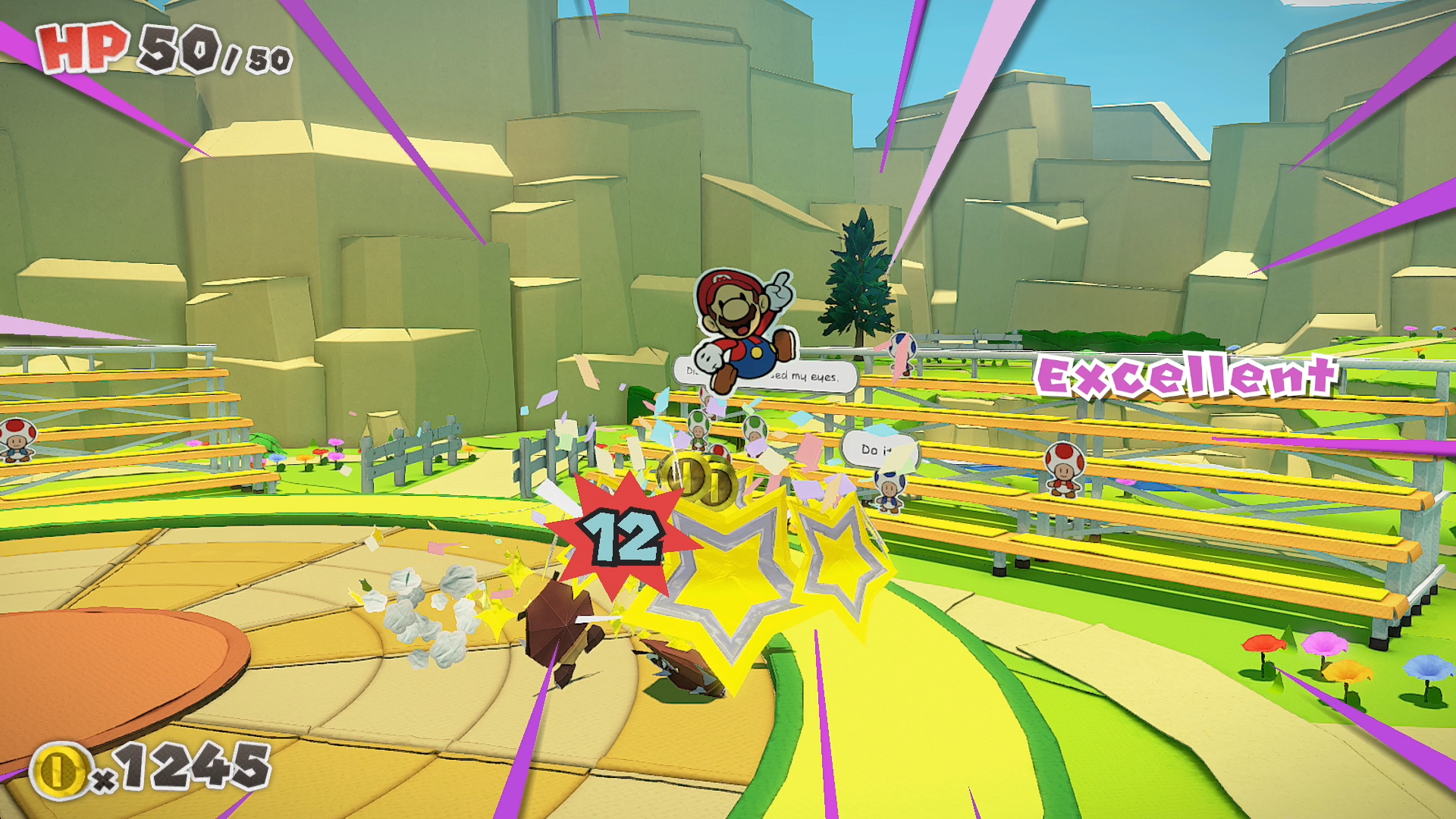
I didn’t end up using these options much, because they tended to be more expensive than the alternative of just sucking it up, failing the puzzle, and taking less of a coin bonus at the end of the battle. And coins are paramount in the world of Origami King. In fact, coins are the only thing its battles give you. You don’t win items, you don’t get experience points — you get cash.
And cash is king. Want to take less damage in battle? You’ll have to buy accessories that bump your defence. Want to deal out more pain? You’ll need to buy (or find hidden in the world) more powerful hammers and boots. These break after several uses, so you’ll need to keep stocking up. (Fortunately, they’re not very expensive, you can carry a lot of them, and they take a while to break.) And if you’re a completionist, you’ll need to spend your coins to fill the in-game museum with collectibles.
One of the criticisms of the last two games is that they actively dissuade you from going into battles at all, since their battles barely give you enough reward to make up for the consumable items you’ll use to win them. Not so in Origami King. I actively sought out battles throughout the game because it rewards you richly for them. And because they’re enjoyable, mostly. When the pieces line up just right and you’re able to wipe out a grid full of enemies without taking a scratch, it feels good!
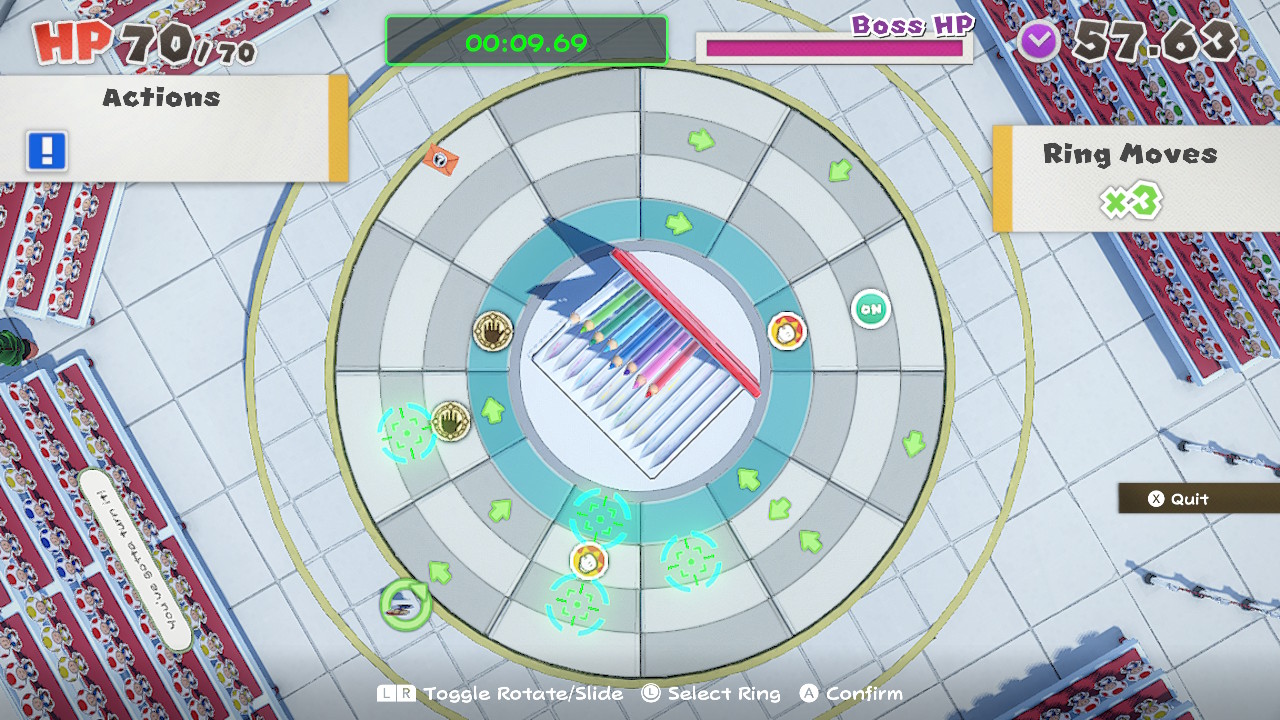
I found the boss battles to be more interesting than the standard ones. When you face off against a boss, they’re in the centre of the rings, while Mario begins on the outside. The rings now become a sort of board game, with arrows, action spaces, helpful items, hazards, etc. You’ve got to arrange them to create a pathway that Mario will walk on, picking up items, avoiding bad things, and finally landing on an action square that will let him attack the enemy (or heal up).
Since there’s no one single solution to these boss battle puzzles, they give you a little bit more leeway to be creative and try to craft the best possible pathway, while still being effective even if you’re not able to scoop up all the rewards on your way to punching the boss. The only annoying thing about some of these battles is that enemies have specific strengths and weaknesses, but you might not find out about these unless you try to do something and fail. (However, since single-use consumable items are never a factor, it’s far less annoying than it could have been.)
There’s even another type of battling in Origami King, which takes place in classic real-time action-RPG style, right out in the field. Giant “Paper Macho” enemies roam the world and need to be dispatched via Mario’s hammer. At first, these are low-stakes affairs — dodge a Goomba, hit it in its weak point, repeat until it explodes in a shower of confetti — but later on you’ll fight entire multi-phase boss monsters in this mode. These encounters are simple enough that you couldn’t build an entire game around them, but are infrequent enough that they’re always a nice break.
Mario’s stats do increase during the adventure, they just don’t do so via EXP earned from battles. Obtainable hearts raise your maximum HP, and when you find one, Olivia comments that you’ve “become a bit stronger, too.” So there are stats, and underlying maths to Mario’s powers. The game just deliberately hides it all.
Where Paper Mario has always excelled is the story. Yes, the broad strokes of it are rote to the point of self-parody by now: Princess Peach is imperiled, a mysterious new character appears to assist Mario, Bowser shows up and lends a hand. It’s not the destination that’s worthwhile, it’s all the stops along the way.
While it couldn’t be called an “open world” by any measure, Origami King’s locations are imaginative, rewarding to explore, and full of detail. As you trek around, you’ll find many “holes” in the paper environments, which you can fill in with confetti to open up new places or just earn a few coins. Levels are also filled with many hidden Toads who have been folded up into origami; as you find more of them, they will fill out the bleachers in the battle arena and give you more rewards when you pay them to cheer you on.
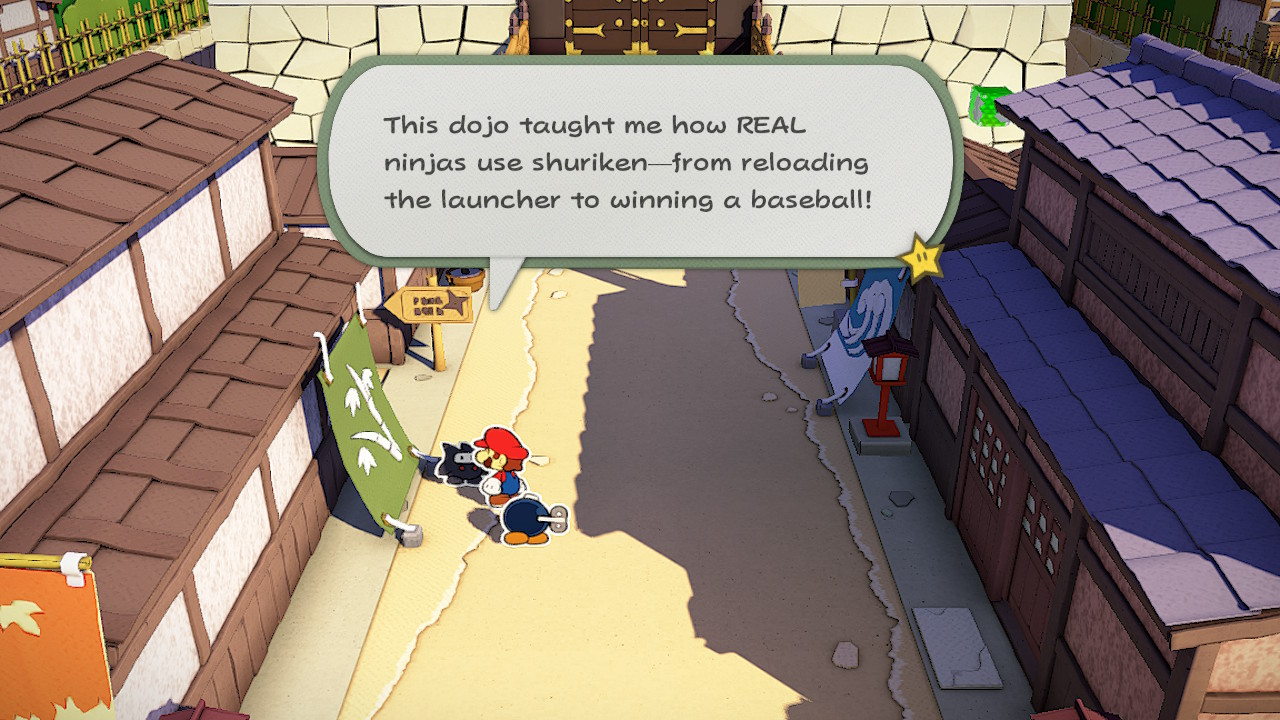
One of my favourite levels, Shogun Studios, is a feudal Japan-themed amusement park slash movie studio that’s clearly based on the real-life Toei Studio Park, just a stone’s throw away from the Kyoto offices where Paper Mario was developed. What seems like a simple gag turns out to be an extensive quest, where you have to explore and unlock the entire park, go through various attractions, and finally unlock the massive theatre at its centre for an epic showdown.
But there are simpler pleasures, too, like exploring a field of autumn trees, sailing on an ocean discovering islands, or riding over rolling desert dunes at night and digging up buried treasure. The artistry on display is always impressive, and paired with a beautiful soundtrack recorded with live instruments.
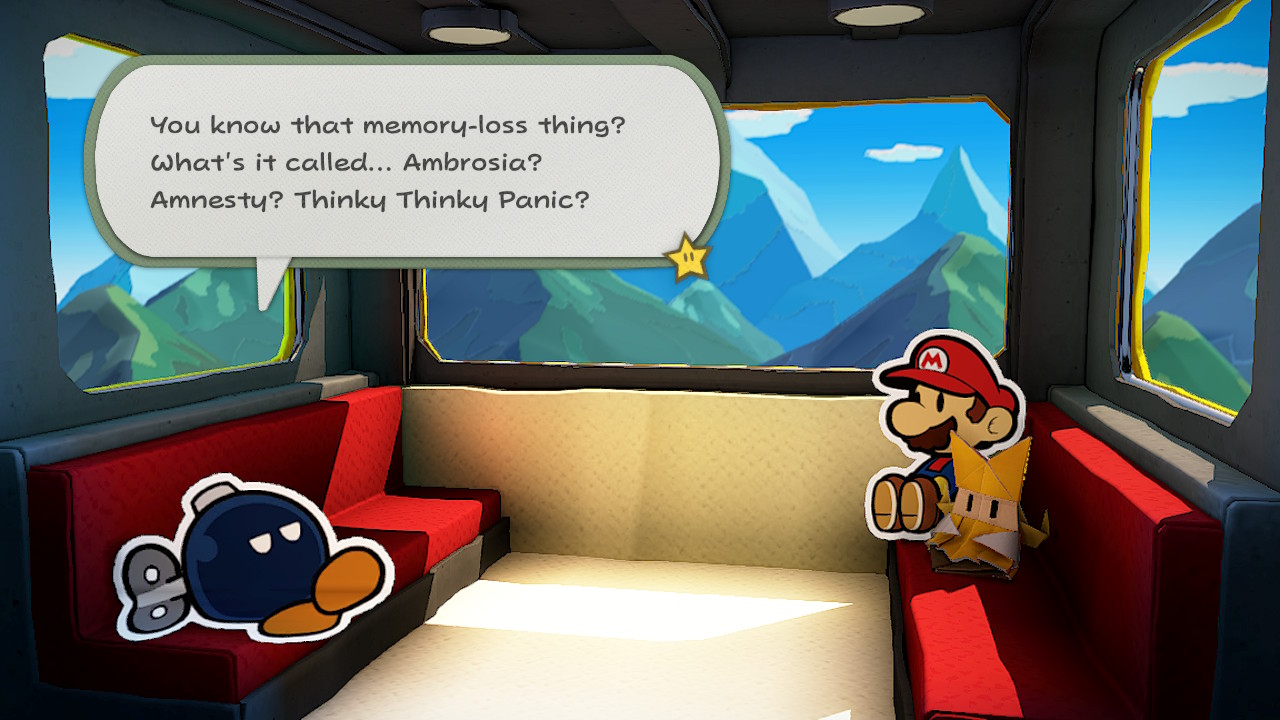
The real pleasure is always when you find someone to talk to. Since the origami soldiers completely overran Mario’s world, Bowser and his minions are all on Mario’s team; this means any standard paper characters you see are friendlies, and you can chat them up to see what’s on their minds. Occasionally one will join up with you for a while, automatically doing assist moves in battle.
I don’t know what the people who write Paper Mario’s English-language scripts are getting paid, but I know that it is not enough. I can’t remember the last game that made me laugh so hard so many times. Often, it’s some kind of deep-cut reference to a previous Mario game. Sometimes it’s a funny observation about real life that’s somehow even funnier when it’s spoken by a Toad. Sometimes you wander into a coffee shop to find a Goomba and a Shy Guy arguing over lattes about which one is the best basic minion. If you love Mario lore, this game is made by people who love it as much as you do, and probably more.
I also now have to do that annoying game-reviewer thing where I say there’s a plot line that really impressed me, but that the embargo for this game review explicitly says that I can’t mention it. Sorry! Just know that there are other excellent things that I’d love to call out about the story, but cannot.
[review heading=”Paper Mario: The Origami King” image=”https://www.kotaku.com.au/wp-content/uploads/sites/3/2020/07/16/b1d2ltfj8pxti2tqgpjv.png” label1=”Back of the box quote” description1=”‘Better than the last two!’” label2=”Type of game” description2=”Not An RPG” label3=”Liked” description3=”Hilarious script, beautiful art style and music, fun action-puzzle battles, some oddly touching moments.” label4=”Disliked” description4=”Some annoying boss battle designs and required minigames.” label5=”Developer” description5=”Intelligent Systems / Nintendo” label6=”Platform” description6=”Nintendo Switch” label7=”Release Date” description7=”July 17, 2020″ label8=”Played” description8=”Finished the main game (over 30 hours), did some side quest stuff but not all of it.” ]
I wish the Switch had a proper gameplay time counter. All I can say is that the Switch tells me that I have played Origami King for “30 hours or more.” There’s no timer on my save file, because in keeping with Paper Mario’s removal of RPG elements, it has no save file system — there’s one single save file attached to each profile on the system that automatically loads when you begin the game.
Either way, it’s a lengthy game, and if you want to squeeze out a few more hours of playtime after dethroning the Origami King, some optional challenges await you out in the fields. But there’s no post-game story or anything like that — you can just go back to right before the final boss and (easily) backtrack out of the level to get back into the world and clean up. The game keeps track of how many hidden Toads, treasures, holes, and hidden question-mark blocks you’ve located, and gives you tools to find the last few you missed on the way.
I’m not sure why Nintendo feels that Paper Mario can’t be a role-playing game: What exactly was the issue with the original games, which were widely praised and sold very well? But the major issue for me was not that Nintendo removed the series’ RPG mechanics, but that what it replaced them with was not as good. Origami King might not be the successor to Thousand-Year Door for which fans have been clamouring, but this time the formula works, allowing the series’ great writing and worlds to shine through.
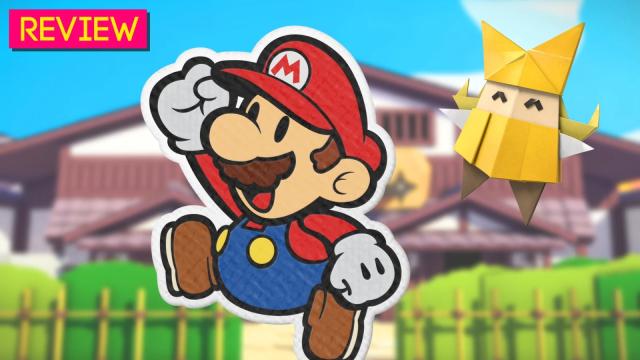
Leave a Reply